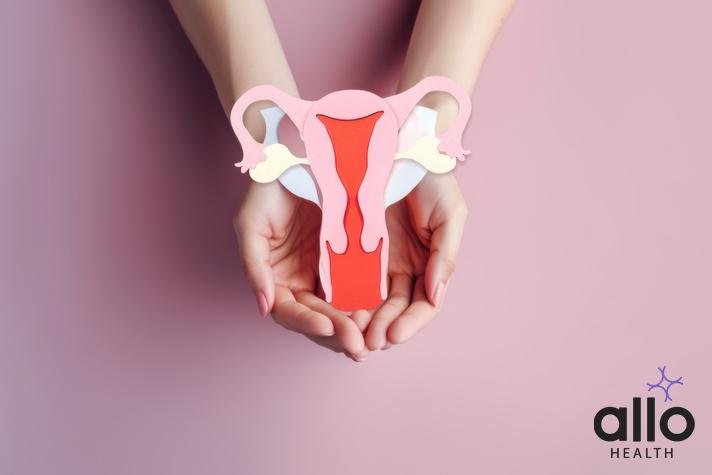Understanding and Managing Reduced Blood Flow During Periods

Allo Health is dedicated to personalized well-being, offering support and trusted information tailored to individual health goals. The platform emphasizes human-generated content, led by a distinguished medical team of experts, including physicians and sexual health specialists. Their commitment to credibility involves rigorous fact-checking, authoritative research, and continuous updates to ensure accurate, up-to-date information. Allo Health's unique approach goes beyond conventional platforms, providing expert-led insights and a continuous commitment to excellence, with user feedback playing a crucial role in shaping the platform's authoritative voice.

Dr.Sushma.V completed MBBS degree from BGS GIMS,bangalore
Why This Was Upated?
Our experts continually monitor the health and wellness space, and we update our articles when new information became available.
Updated on 10 April, 2024
- Article was updated as part of our commitment to diversity, equity, and inclusion.

"The following blog article provides general information and insights on various topics. However, it is important to note that the information presented is not intended as professional advice in any specific field or area. The content of this blog is for general educational and informational purposes only.
Book consultation
The content should not be interpreted as endorsement, recommendation, or guarantee of any product, service, or information mentioned. Readers are solely responsible for the decisions and actions they take based on the information provided in this blog. It is essential to exercise individual judgment, critical thinking, and personal responsibility when applying or implementing any information or suggestions discussed in the blog."
Menstrual cycles vary widely among individuals, with differences in duration, pain, and flow levels. A common concern for many is experiencing reduced or no proper blood flow during periods, a condition that can cause confusion and anxiety. This article delves into the causes, implications, and management strategies for decreased menstrual flow, aiming to provide valuable insights and reassurance to those affected.
Causes of Reduced Blood Flow During Periods
Reduced blood flow during menstruation, medically referred to as hypomenorrhea, can result from various factors, ranging from hormonal imbalances to lifestyle choices. Understanding these causes is the first step towards managing the condition effectively.
- Hormonal Imbalances: Fluctuations in estrogen and progesterone can significantly affect your menstrual cycle, leading to lighter periods.
- Lifestyle Factors: High-stress levels, significant weight loss or gain, and rigorous exercise routines can disrupt your cycle.
- Underlying Medical Conditions: Conditions such as polycystic ovary syndrome (PCOS), thyroid disorders, and uterine scarring can lead to reduced flow during periods.
- Contraceptive Use: Certain birth control methods, especially hormonal IUDs, can lead to lighter periods over time.
Implications of Reduced Blood Flow
While a lighter flow might not always signal a serious issue, understanding its implications is crucial for bodily awareness and health.
- Fertility Concerns: In some cases, reduced flow can indicate potential fertility issues, especially if linked to conditions like PCOS.
- Health Monitoring: A sudden change in menstrual flow can be a sign to monitor your health more closely and consult a healthcare provider.

Management and Treatment
Addressing reduced blood flow during periods involves a combination of lifestyle adjustments, medical treatment, and in some cases, natural remedies.
- Lifestyle Changes: Stress management techniques, maintaining a healthy weight, and regular exercise can help regulate your menstrual cycle.
- Medical Intervention: For underlying health conditions, seeking medical advice is essential. Treatments may include hormonal therapy or medication adjustments.
- Natural Remedies: Dietary changes, such as increasing iron and vitamin B intake, can also support menstrual health.
It’s important to consult a healthcare provider if you notice significant changes in your menstrual flow, especially if accompanied by other symptoms like severe pain or irregular cycles. A professional can help diagnose any underlying issues and recommend appropriate treatments.
Understanding Light Periods
When your period appears lighter than usual, it can stir a mix of emotions and questions about your health. While a light period often isn’t a reason for alarm, it’s essential to understand the potential causes behind this change. This article aims to shed light on why you might experience lighter periods, common causes for such changes, and when it’s crucial to consult a healthcare provider.
Pregnancy: For those sexually active, pregnancy is a primary cause of changes in menstrual cycles. Up to 25% of pregnant individuals may experience spotting or breakthrough bleeding in early pregnancy, often mistaken for a light period. This spotting, known as implantation bleeding, occurs when the fertilized egg attaches to the uterine wall. It can range in color from light pinkish-red to dark brown and may come with or without cramps.
Lactation: Breastfeeding can lead to lighter periods due to high levels of prolactin, a hormone that stimulates milk production and can suppress ovulation. Periods during lactation may be lighter or shorter and typically return to normal once breastfeeding stops.
Weight Changes: Sudden weight loss or gain can impact your menstrual cycle. Being underweight can halt ovulation due to fat loss, while excessive exercise can alter hormone levels, affecting your periods.
Stress: Stress, whether emotional or due to significant life changes, can affect your body and alter your menstrual cycle, leading to lighter periods.
Birth Control: Hormonal birth control methods, such as pills or hormonal IUDs, can lead to lighter and shorter periods. If the change in period flow due to birth control is bothersome, discussing alternative methods with a healthcare provider is advisable.
Age: As you get older, especially nearing menopause, periods may become lighter. This change doesn’t necessarily mean a decrease in fertility, but contraception is still recommended until menopause is confirmed.
Medical Conditions:
Various medical conditions can cause lighter periods:
- Thyroid Disorder: Affects the menstrual cycle due to hormonal regulation.
- Polycystic Ovary Syndrome (PCOS): This leads to lighter periods due to hormone disruptions.
- Asherman’s Syndrome: Uterine scarring can cause lighter flow and trapped menstrual blood.
When to See a Healthcare Provider
It’s crucial to consult a healthcare provider if you experience a significant change in your menstrual flow, especially if it’s consistently lighter than usual. Additionally, seek medical advice if you experience symptoms such as fever, pelvic pain, or unusual vaginal discharge. Pregnancy should also be ruled out if there’s a possibility, as early spotting could be mistaken for a light period.
Monitoring Your Menstrual Health
Tracking your menstrual cycle can provide valuable insights into your health and help identify any changes early. Consider using a period tracker app or simply noting details in your calendar. This record can be beneficial during consultations with your healthcare provider.
A light period can result from various factors, including natural changes, lifestyle factors, medical conditions, and the use of birth control. While it’s often not a cause for concern, understanding these potential causes is key to managing your menstrual health effectively. If you notice significant changes in your menstrual flow or experience symptoms that concern you, consulting a healthcare provider is essential for proper diagnosis and management.
Distinguishing Spotting from Your Period: Key Differences and When to Seek Medical Advice
Understanding whether you’re experiencing spotting or undergoing your regular menstrual period is crucial for monitoring your reproductive health. Several distinguishing factors, such as the volume of blood loss, color, and accompanying symptoms, can help you differentiate between the two.
Spotting Explained
- Bleeding Volume: Spotting is characterized by very light bleeding, significantly less than what you would experience during a period.
- Protection Needed: A pantyliner is usually sufficient for spotting due to the minimal amount of blood.
- Color: The blood seen during spotting can be light red, pink, or brown.
- Duration and Timing: Spotting can occur at any time of the month and may last variably.
- Associated Symptoms: While spotting can occur with no additional symptoms, depending on its cause, there may be other signs to watch for.
Period Defined
- Bleeding Volume: Menstrual bleeding involves a mix of heavy, medium, and light days.
- Protection Needed: A tampon, pad, or menstrual cup is typically required to manage the flow.
- Color: Menstrual blood can vary in color, including dark red, bright red, brown, or pink.
- Duration and Timing: A typical period lasts between 3 to 7 days and occurs in a monthly cycle every 24 to 38 days.
- Associated Symptoms: Common symptoms include acne, bloating, fatigue, breast tenderness, changes in bowel habits, mood swings, insomnia, difficulty concentrating, anxiety, and a fluctuation in sexual desire.
When to Consult a Doctor
Occasional spotting instead of a regular period might not be alarming. It could result from stress, hormonal shifts as you approach menopause, or other non-serious factors, often resolving without medical intervention.
However, if spotting arises from conditions like Polycystic Ovary Syndrome (PCOS), thyroid disorders, sexually transmitted infections (STIs), or pregnancy, it might be accompanied by other symptoms that warrant a doctor’s visit.
Immediate medical attention is recommended if your spotting is associated with:
- Pain
- Fever or chills
- Foul-smelling discharge
- Signs of an infection
Spotting occasionally instead of having a period can be a normal part of your menstrual cycle due to various factors affecting hormonal balance. Keeping track of your menstrual cycle, including the frequency, color, and volume of bleeding or spotting, using traditional methods or a tracking app like Clue, can be helpful.
If spotting comes with additional symptoms that cause concern, reaching out to your healthcare provider is essential to rule out any underlying conditions and receive appropriate care.
How to Enhance Menstrual Blood Flow
Increasing menstrual flow involves understanding your body’s natural rhythms and health. Emmenagogues, or herbs that promote blood flow to the pelvic area and uterus, are commonly recommended. Below are natural foods and remedies suggested to support a healthier menstrual flow:
- Beetroot Juice: Rich in iron, vitamins, and fiber, beetroot juice boosts blood circulation and can enhance menstrual flow by increasing hemoglobin levels.
- Dark Chocolate: Known for its comforting effect, dark chocolate also contains minerals that help regulate blood flow during periods and alleviate discomfort.
- Jaggery: This traditional sweetener is high in iron, promoting increased blood flow. Its heat-inducing quality makes it a go-to remedy for enhancing menstrual flow.
- Coconut: Consuming shredded coconut, especially with jaggery, can naturally increase period flow due to its iron content.
- Spinach Juice: High in vitamin K, spinach supports normal blood flow and can be particularly beneficial for those with irregular periods.
- Sesame Seeds: A mixture of sesame seeds and jaggery, both heat-inducing foods, can regulate and improve menstrual blood flow.
- Cinnamon: This warming spice is not only comforting but has been shown to help manage menstrual cycles, particularly for those with PCOS.
- Turmeric: Known for its healing properties, turmeric can help regulate menstruation and balance hormones.
- Unripe Papaya: Aiding in uterine muscle fiber contractions, unripe papaya can help regulate menstrual flow. Consumed with coconut water, it also keeps the body cool.
- Pineapple: This fruit’s nutrients help in uterine muscle contraction and improve blood circulation, potentially increasing menstrual flow.

Additional Ways to Promote Healthy Menstrual Flow
Managing and promoting a healthy menstrual flow goes beyond dietary interventions. Incorporating holistic lifestyle changes can make a significant difference in achieving a regular and healthy menstrual cycle. Here are additional strategies to consider:
Regular Exercise
- Enhances Blood Circulation: Regular physical activity improves overall blood circulation, which can help promote a healthier menstrual flow.
- Balances Hormones: Exercise is known to help balance hormonal levels, reducing the risk of irregular periods.
- Stress Reduction: Physical activity is a great stress reliever. Since stress can negatively impact your menstrual cycle, regular exercise can help mitigate these effects.
Yoga
- Promotes Relaxation: Yoga can decrease stress levels through its meditative practices and breathing exercises, directly influencing menstrual health.
- Improves Pelvic Health: Certain yoga poses are designed to improve the health of the pelvic region, potentially leading to better menstrual flow.
- Hormonal Balance: Yoga may aid in regulating hormones that control the menstrual cycle, contributing to a more consistent flow.
Hydration
- Maintains Blood Volume: Adequate hydration is crucial for maintaining the volume of blood, which can influence menstrual flow. A well-hydrated body ensures that the blood can flow more freely.
- Detoxification: Drinking enough water helps in flushing out toxins from the body, which can have a positive effect on your menstrual health.
- Supports Nutrient Transport: Water is essential for the transport of nutrients in the body, which is necessary for maintaining hormonal balance and supporting the menstrual cycle.
Stress Management
- Mindfulness and Meditation: Engaging in mindfulness practices and meditation can significantly reduce stress levels, positively affecting menstrual regularity and flow.
- Adequate Sleep: Ensuring you get enough sleep is crucial for hormonal balance and can reduce stress, supporting a healthier menstrual cycle.
Warm Compresses
- Ease Menstrual Cramps: Applying a warm compress or heating pad to the abdominal area can help relax the muscles, potentially leading to a more comfortable and possibly heavier flow.
By integrating these practices into your routine, you can support your body’s natural processes and promote a healthier menstrual cycle. Remember, consistency is key, and it’s essential to listen to your body and consult with healthcare professionals for personalized advice.
Conclusion
Experiencing no proper blood flow during periods can be concerning, but it’s often manageable with the right approach. Understanding the potential causes and when to seek medical advice is crucial. Remember, every individual’s body is different, and what’s normal for one person may not be for another. Prioritizing your health and well-being by staying informed and proactive in managing your menstrual health is key.
Most Asked Questions
-
What causes reduced blood flow during periods?
Reduced blood flow during periods, or hypomenorrhea, can be caused by a variety of factors including hormonal imbalances, lifestyle changes (such as stress, significant weight loss or gain, and intense exercise), underlying medical conditions (like PCOS, thyroid disorders, and uterine scarring), and the use of certain contraceptives, particularly hormonal IUDs.
-
Can a lighter period flow indicate fertility issues?
While not always the case, a lighter period flow can sometimes suggest potential fertility concerns, especially if it's linked to conditions like polycystic ovary syndrome (PCOS). However, many individuals with lighter periods do not experience fertility issues. Consulting with a healthcare provider can offer more personalized insight.
-
How can I naturally increase my period flow?
Natural remedies to enhance blood flow during periods include consuming foods rich in iron and vitamins, such as beetroot juice, dark chocolate, jaggery, and spinach juice. Herbs known as emmenagogues, like cinnamon and turmeric, can also promote blood flow to the pelvic area. Regular exercise, yoga, and maintaining hydration are additional ways to support a healthier menstrual flow.
-
When should I see a doctor for light periods?
It's advisable to consult a healthcare provider if you notice significant changes in your menstrual flow, especially if your periods become consistently lighter than usual or if you experience other symptoms such as severe pain, irregular cycles, fever, or signs of infection. Early consultation can help diagnose any underlying issues and recommend appropriate treatment.
-
How can tracking my menstrual cycle help?
Tracking your menstrual cycle can provide valuable insights into your overall reproductive health and help you notice any changes in your period flow, duration, and accompanying symptoms. This information can be extremely useful during consultations with your healthcare provider, aiding in the diagnosis and management of any menstrual health concerns.








































